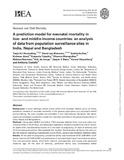| dc.contributor.author | Houweling, Tanja A.J. | |
| dc.contributor.author | van Klaveren, David | |
| dc.contributor.author | Das, Sushmita | |
| dc.contributor.author | Azad, Kishwar | |
| dc.contributor.author | Tripathy, Prasanta | |
| dc.contributor.author | Manandhar, Dharma | |
| dc.contributor.author | Neuman, Melissa | |
| dc.contributor.author | de Jonge, Erik | |
| dc.contributor.author | Been, Jasper V. | |
| dc.contributor.author | Steyerberg, Ewout | |
| dc.contributor.author | Costello, Anthony | |
| dc.date.accessioned | 2021-02-24T11:55:47Z | |
| dc.date.available | 2021-02-24T11:55:47Z | |
| dc.date.issued | 2019 | |
| dc.identifier.citation | Tanja A J Houweling, David van Klaveren, Sushmita Das, Kishwar Azad, Prasanta Tripathy, Dharma Manandhar, Melissa Neuman, Erik de Jonge, Jasper V Been, Ewout Steyerberg, Anthony Costello, A prediction model for neonatal mortality in low- and middle-income countries: an analysis of data from population surveillance sites in India, Nepal and Bangladesh, International Journal of Epidemiology, Volume 48, Issue 1, February 2019, Pages 186–198, https://doi.org/10.1093/ije/dyy194 | |
| dc.identifier.uri | https://opendocs.ids.ac.uk/opendocs/handle/20.500.12413/16366 | |
| dc.description.abstract | Background: In poor settings, where many births and neonatal deaths occur at home, prediction models of neonatal mortality in the general population can aid public-health policy-making. No such models are available in the international literature. We developed and validated a prediction model for neonatal mortality in the general population in India, Nepal and Bangladesh.
Methods: Using data (49 632 live births, 1742 neonatal deaths) from rural and urban surveillance sites in South Asia, we developed regression models to predict the risk of neonatal death with characteristics known at (i) the start of pregnancy, (ii) start of delivery and (iii) 5 minutes post partum. We assessed the models’ discriminative ability by the area under the receiver operating characteristic curve (AUC), using cross-validation between sites.
Results: At the start of pregnancy, predictive ability was moderate {AUC 0.59 [95% confidence interval (CI) 0.58–0.61]} and predictors of neonatal death were low maternal education and economic status, short birth interval, primigravida, and young and advanced maternal age. At the start of delivery, predictive ability was considerably better [AUC 0.73 (95% CI 0.70–0.76)] and prematurity and multiple pregnancy were strong predictors of death. At 5 minutes post partum, predictive ability was good [AUC: 0.85 (95% CI 0.80–0.89)]; very strong predictors were multiple birth, prematurity and a poor condition of the infant at 5 minutes.
Conclusions: We developed good performing prediction models for neonatal mortality. Neonatal deaths are highly concentrated in a small group of high-risk infants, even in poor settings in South Asia. Risk assessment, as supported by our models, can be used as a basis for improving community- and facility-based newborn care and prevention strategies in poor settings. | |
| dc.publisher | Oxford University Press on behalf of the International Epidemiological Association | |
| dc.rights.uri | https://creativecommons.org/licenses/by/4.0/ | |
| dc.title | A Prediction Model for Neonatal Mortality in Low- and Middle-income Countries: An Analysis of Data from Population Surveillance Sites in India, Nepal and Bangladesh | |
| dc.type | Article | |
| dc.rights.holder | © The Author(s) 2018 | |
| dc.identifier.externaluri | https://doi.org/10.1093/ije/dyy194 | |
| dc.identifier.ag | ES/I033572/1 | |
| dc.identifier.doi | 10.1093/ije/dyy194 | |
| dc.rights.license | https://creativecommons.org/licenses/by/4.0/ | |


